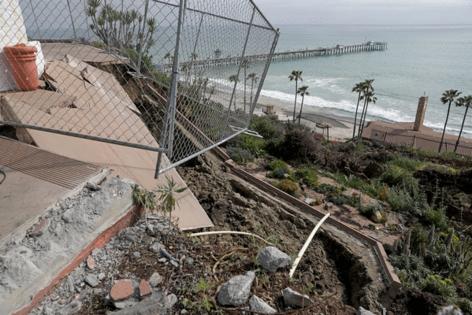Phil Diehl, The San Diego Union-Tribune
on May 5, 2024

A coordinated, multiagency effort is essential to save Southern California's coastal rail corridor from sea-level rise and erosion, state Sen. Catherine Blakespear warned last week.
"The data is clear and the message more urgent than ever that our coastline near the rail line is at critical risk of failure," said Blakespear, D-Encinitas, at a hearing held by the Subcommittee on LOSSAN Rail Corridor Resiliency that she chairs in Sacramento
Seven different state and regional administrators updated the subcommittee Monday on the status of problem areas along the 351-mile-long Los Angeles-San Diego-San Luis Obispo rail corridor, focusing primarily on trouble spots in San Diego County and San Clemente in neighboring Orange County. The route is San Diego's only passenger and freight train connection to Los Angeles and the rest of the United States.
Sections of the railroad in Del Mar and San Clemente are especially vulnerable.
About 1.7 miles of the track in Del Mar follows the edge of a tall, fragile bluff 60 feet above the ocean. The San Diego Association of Governments, the regional planning agency, has been working for years on plans to reroute the tracks into a tunnel away from the bluff, but that won't happen until at least 2035.
In San Clemente, a seven-mile stretch of the track runs along the shrinking beach below crumbling bluffs.
"The rail is getting attacked from both sides," said San Clemente City Manager Andy Hall. Mother Nature has assaulted the tracks there from the west by scouring the sand from the beach, and from the east by weakening the steep bluff and unleashing landslides.
The Orange County Transportation Authority recently began considering long-term solutions for the seven miles of beachfront track there, including the possibility of a new inland route. However, the relocation there is uncertain and, if chosen, is decades in the future.
Any solution, even a quick one, is expensive. The Orange County Transporation Authority, working with Metrolink, spent $9.2 million on cleanup and construction of a catchment wall finished in March after a landslide at Mariposa Point in San Clemente.
In December 2023, the OCTA identified four new trouble spots that need protection from beach erosion and possible slope failures, said Darrell Johnson, the agency's chief executive officer.
"Potential solutions, in a perfect world ... would need to be in place ... or substantially underway, by the fall of 2024 ahead of the next storm season," Johnson said.
A rough estimate of the cost for the work needed immediately is $210 million to $310 million, he said. A more realistic time frame is that it would take up to four years to plan, engineer, obtain funding and build the projects.
Several presenters at the hearing emphasized the need for a multipronged approach to protect the tracks.
The three basic tactics are: replenishing sand on the beaches, adding and expanding rock revetments west of the tracks and installing barrier-like catchment walls east of the tracks where they are threatened by landslides.
Sand replenishment is widely considered the best answer.
Along with protecting the railroad, wider beaches preserve access to the coast and provide the recreational spaces loved by residents and visitors alike. Also, many people consider sand to be a more nature-based solution to the railroad's problems than building walls or dumping rocks that can contribute to beach erosion.
However, dredging sand from the ocean, harbors and lagoons to widen beaches is costly and time-consuming. Also, eventually the sand washes away again.
"It's probably not realistic to expect a nature-based solution would hold up all by itself," said California Coastal Commission Executive Director Kate Huckelbridge. "We understand the need for sort of a multicomponent, but it (sand) should be a major part of any project."
In Del Mar, the Coastal Commission approved new seawalls in 2022 as part of the ongoing efforts to protect the blufftop tracks until a new route is completed. However, the Coastal Commission also required the installation of stairways and trails as part of the project to preserve public access to the beach.
Overall rail ridership remains down from the pre-pandemic highs of 2019. However, passengers are slowly returning.
Amtrak ridership on a rider-per-mile basis in March of this year, when limited service was restored after the Mariposa Point slide, reached 101% of March 2019, said Los-Angeles-San Diego-San Luis Obispo (LOSSAN) Rail Corridor Agency Managing Director Jason Jewel.
By the end of this March, Amtrak restored service to its previous level of 10 round-trip daily trains between San Diego and Los Angeles. As a result, April ridership is forecast to increase by 8% to 10% over March, Jewel said.
Amtrak expects the upward trend to continue through the summer, when more people tend to choose the train for vacation travel and for special events such as the X-Games in Ventura, the horse races at Del Mar and Comic-Con in San Diego.
Tuesday's hearing was the subcommittee's fourth, the second this year. After its meeting in January, the subcommittee sent a letter to the California State Transportation Agency suggesting a formalized partnership among the agencies using the corridor.
The state agency has a "working group" that helps to identify and respond to issues along the corridor, but so far has taken no steps toward an official partnership.
_____
©2024 The San Diego Union-Tribune. Visit sandiegouniontribune.com. Distributed by Tribune Content Agency, LLC.
No comments:
Post a Comment